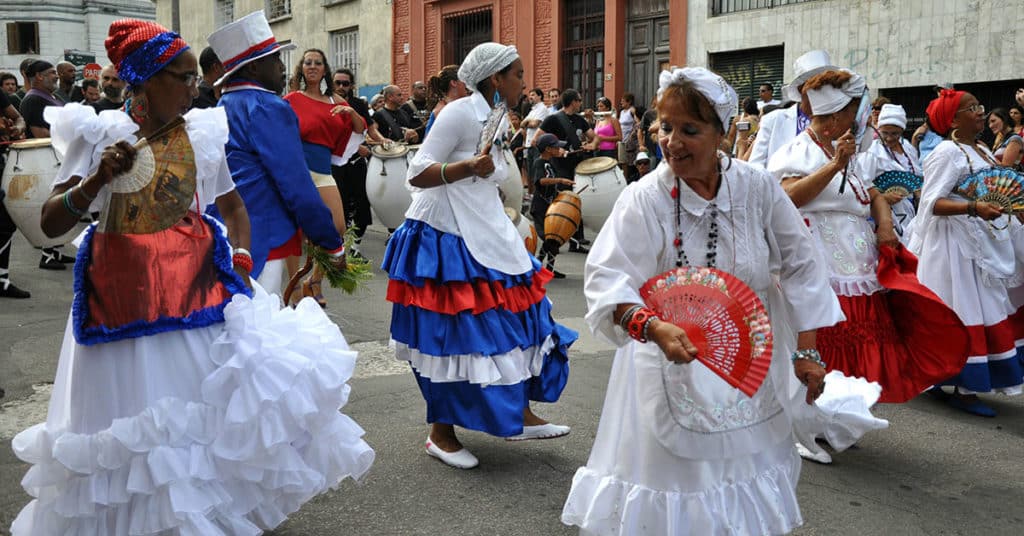National Candombe Day celebrates the Afro-Uruguayan drum, song and dance tradition on December 3, in part to honor our African heritage and promote racial equality.
Candombe is the sound of Uruguayan Carnival. It’s easy to assume that these are folkloric traditions only celebrated for tourists, but the traditions still live in local communities. Being non-European, the traditions used to be suppressed, but now young Uruguayans are rediscovering candombe as a marker of Uruguayan identity.
Candombe
Candombe is the Uruguayan form of African Diaspora drum, song, and dance traditions that developed across the Americas. Distinct, but similar traditions include Brazilian samba, Cuban rumba, Haitian meríngue, Puerto Rican bomba, Columbian cumbia, Mexican fandango, Venezuelan tambor, Peruvian festejo, and many other regional traditions.
The drum was the first mass media. It’s sound was notice that either a religious ceremony or a party was starting. Everyone in town, or in your barrio, went because this was your family, faith, and community. There would usually be some buying and selling going on, and the community drum circle was also where you would find love. It was the town mall, the center of community back in the day.
This is an African Diaspora tradition that has become an Uruguayan national tradition. It was the first tradition where we noticed that all peoples seemed to participate in what was an African Diaspora tradition. It helped us realize how much African Diaspora traditions have been internalized in many cultural traditions.
The same is true in the United States where most American popular culture originates in African American communities. The blues is the root of American song and dance traditions. You can say that candombe is Uruguayan blues.
National Candombe Day

In Uruguay, National Candombe Day is December 3.
Candombe Derives from Candomble, the African Diaspora Religion
Human culture usually begins as religious ritual at home. The three African Diaspora religions to root in the Americas are Dahomey in Haiti, New Orleans and the Caribbean; Yoruba in Cuba and the Caribbean; and Kongo in Brazil. These are beautiful religions, the equal of any other. In the Americas they are blended with Catholicism. They are each unique, but similar, and are actually mixed together everywhere in the Americas. Cuban Yoruba traditions are most familiar to Americans, but even they are a blend of Dahomey, Yoruba, and Kongo traditions.
In the same way that the chanting of Roman monks evolved into European classical music, African Diaspora religious traditions evolved into popular traditions. Dahomey drum, song, and dance traditions became Haitian meríngue, which most Americans know as Dominican merengue. Yoruba traditions became Cuban rumba. Candomblé traditions became Brazilian samba and later bossa nova jazz.
Uruguayan candombe derives from Brazilian Candomblé. The religions still thrive in the barrios, but for many people the traditions have lost their religious meanings. They have become popular culture.
Candombe is One of the Roots of Tango
Many people think tango is European culture because the Argentines are mostly Italian and tango is very Europeanized, but it is originally African Diaspora culture. Tango’s counterclockwise line of dance is an enactment of the Yowa, the Kongo cosmological diagram which mirrors the daily journey of the sun, and psychological journey of life.
Uruguay is sandwiched between Argentina and Brazil, so Uruguayan culture, though unique, is influenced by both neighbors.
Candombe becomes tango like this:
- Brazilian Candomblé (religion)
- Uruguayan Candombe (2/2)
- Uruguayan/Argentine Milonga (2/2)
- Uruguayan/Argentine Tango (4/4)
Argentines claim tango as their own, but we are pretty certain that tango begins in Montevideo, Uruguay.
Tango now has three dances: milonga, tango, and valz. Milonga derived from candombe. Both are in 2/2 time. With European influences, milonga evolved into tango in 4/4 time. That’s what Argentines call the 2×4, the transition from milonga to tango.
Valz came from European waltz because in the 1910s, rich Argentines used to send their children to Europe for education, and Argentina was then one of the 10 richest countries in the world. When those young Argentines returned home, they brought valz into the tango mix.
Argentine composer Juan Carlos Cáceres (Buenos Aires, 1936) is one of the contemporary masters of milonga and its predecessor candombe. His “Tango Negro” (Black tango) is a classic song in the form.
This is Keith Widyolar’s own research, so if you are going to repeat it, please credit.
Tango Nuevo Has Candombe Influences
Once you learn to recognize the Candombe rhythm, you hear it a lot in tango nuevo, the club tango of the 2000s. Gotan Project, Bajafondo and other masters of the Tango Nuevo form all brought Candombe into the mix.
Gotan Project’s “Notas” even calls it out, “Africanos en las pampas Argentinas, Toques y llamada de tambores, candombe, tango, Un gaucho y una guitarra…” (Africans in the Argentine pampas, playing the drum, Candombe, Tango, a gaucho (South American cowboy) and a guitar.)
So candombe was mostly absorbed by tango, but its influence reappears in tango nuevo.
